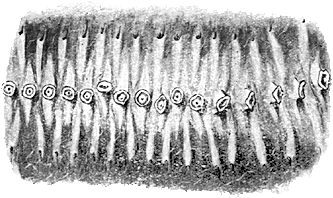Opisthoteuthis persephone
Richard E. Young and Michael VecchioneIntroduction
O. persephone was described from 8 specimens taken off Western Australia the largest of which, apparently, is the holotype which is 330 mm in arm span (arm tip to arm tip). This species needs to be redescribed from new material from the type locality.
Characteristics
- Arms and web
- Female: largest suckers possibly numbers 12-18, nearly uniform over much of arm.
- Cirri with narrow pockets into which they can contract.
- Sucker numbers (holotype): arm I - 78, arm II - 78, arm III - 72, arm IV - 72. [O'Shea states that arm sucker counts reach 93.]
Comments
The above description is taken from Berry (1918) except where indicated otherwise. More details of the description of O. persephone can be found here although the species has been incompletely described.
O. persephone differs from the New Zealand species O. mero in the number of primary gill lamellae (almost always 6 vs almost always 7) (O'Shea, 1999). It differs from the sympatric O. pluto in its pigmentation (Berry, 1918) and fewer gill lamellae (usually 6 vs 8).
Distribution
Type locality: 42 miles south and east of Genoa Peak, Victoria, in the great Australian bight, 480 m. Known also from off Eucla, Western Australia from depths of 277 - 554 m (Berry, 1918).
References
Berry, S.S. 1918. Report on the Cephalopoda Obtained by the F.I.S. "Endeavour" in the Great Australian Bight and Other Southern Australian Localities. Biological Results of the Fishing Experiments carried on by the F.I.S. "Endeavour", 1909-1914, 4(5):201-298.
Nesis, K. N. 1982/87. Abridged key to the cephalopod mollusks of the world's ocean. 385+ii pp. Light and Food Industry Publishing House, Moscow. (In Russian.). Translated into English by B. S. Levitov, ed. by L. A. Burgess (1987), Cephalopods of the world. T. F. H. Publications, Neptune City, NJ, 351pp.
O'Shea, Steve. 1999. The Marine Fauna of New Zealand: Octopoda (Mollusca: Cephalopoda). NIWA Biodiversity Memoir 112: 280pp.
About This Page
Richard E. Young

University of Hawaii, Honolulu, HI, USA
Michael Vecchione

National Museum of Natural History, Washington, D. C. , USA
Page copyright © 2016 Richard E. Young and Michael Vecchione
 Page: Tree of Life
Opisthoteuthis persephone .
Authored by
Richard E. Young and Michael Vecchione.
The TEXT of this page is licensed under the
Creative Commons Attribution-NonCommercial License - Version 3.0. Note that images and other media
featured on this page are each governed by their own license, and they may or may not be available
for reuse. Click on an image or a media link to access the media data window, which provides the
relevant licensing information. For the general terms and conditions of ToL material reuse and
redistribution, please see the Tree of Life Copyright
Policies.
Page: Tree of Life
Opisthoteuthis persephone .
Authored by
Richard E. Young and Michael Vecchione.
The TEXT of this page is licensed under the
Creative Commons Attribution-NonCommercial License - Version 3.0. Note that images and other media
featured on this page are each governed by their own license, and they may or may not be available
for reuse. Click on an image or a media link to access the media data window, which provides the
relevant licensing information. For the general terms and conditions of ToL material reuse and
redistribution, please see the Tree of Life Copyright
Policies.
- First online 13 May 2003
Citing this page:
Young, Richard E. and Michael Vecchione. 2003. Opisthoteuthis persephone . Version 13 May 2003 (under construction). http://tolweb.org/Opisthoteuthis_persephone/20164/2003.05.13 in The Tree of Life Web Project, http://tolweb.org/








 Go to quick links
Go to quick search
Go to navigation for this section of the ToL site
Go to detailed links for the ToL site
Go to quick links
Go to quick search
Go to navigation for this section of the ToL site
Go to detailed links for the ToL site